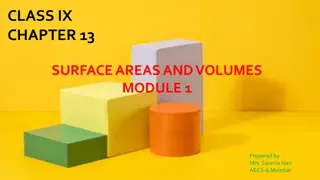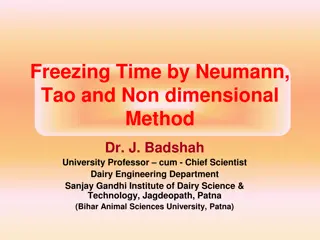Mastering Volume and Scale Calculations for Three-Dimensional Shapes
Dive into advanced 3D shapes volume calculations and scale manipulations to solve for unknown values using various formulas. Explore packaging arrangements, surface area calculations, and map scale conversions for real-world applications. Practice working with complex shapes like cones, spheres, and prisms to enhance your spatial reasoning skills.
Uploaded on Oct 04, 2024 | 1 Views
Download Presentation

Please find below an Image/Link to download the presentation.
The content on the website is provided AS IS for your information and personal use only. It may not be sold, licensed, or shared on other websites without obtaining consent from the author.If you encounter any issues during the download, it is possible that the publisher has removed the file from their server.
You are allowed to download the files provided on this website for personal or commercial use, subject to the condition that they are used lawfully. All files are the property of their respective owners.
The content on the website is provided AS IS for your information and personal use only. It may not be sold, licensed, or shared on other websites without obtaining consent from the author.
E N D
Presentation Transcript
LEVEL 4 THREE DIMENSIONAL SHAPES VOLUME TOPIC 2 LESSON OBECTIVES: (what we want to know/or do at the end of the lesson) 2.2.4 Manipulate given formulae to calculate the unknown values when the perimeter/circumference, area and volume of the following shapes are given: - square; - rectangle; - triangle; - circle; - semi-circle; - cube; - rectangular prism; - triangular prism; - cylinder; - sphere; Cone 2.3.1 Use a given scale on a plan and/or map where the measurements are known to calculate actual length and distance. 2.3.2 Calculate map and/ or plan measurements when actual lengths and distance are known using a given scale. 2.3.3 Determine the scale of a map/plan or model derived from given information. 2.4.1 Use various packaging arrangements of objects (e.g. blocks, balls, cans and boxes) to determine the most appropriate way to package the objects for optimal usage of space. 2.4.4 Build or draw diagrams of 3D scale models of objects from 2D plans (nets) of the object to visualise the object (e.g. build a model of a house from its plan). B ADAMS - 1
SURFACEAREAANDVOLUMEFORMULAE B ADAMS 2
WHATWENEEDTOKNOW: In the previous slide, I added the formula sheet for surface area and Volume. Surface area if we take a box (rectangular prism) and the question ask to work out the surface area. We use the formula above 2lb + 2lh + 2bh (Remember that a box has six faces meaning that we are actually working out six areas and adding them together top, bottom, 2 sides, front and back) B ADAMS h b ll 3 (2 x l x b) + (2 x l x h) + (2 x b x h)
CONTINUE Volume it is not new to you, as we have been doing this from L2. But just note the new shapes that was added sphere (ball), Cone, triangular prim, meaning new formulae to get to know and practice. B ADAMS Scale We have done this in Topic 1, with the help of cross-multiplication or your own method. Scale of 1 : 50 000 - means that for every one centimeter on the map it is 50 000 centimeters in real life. If no dimensions given. YOU MUST KNOW THAT IT IS CENTIMETERS. The questions on scale can go two ways 1. They can ask you to work out the actual length or distance. 2. They can give you the real length or distance and ask you to work out the map/plan distance. 4
SCALE: How to calculate plan/map measurement when actual(real) length or distance are known. Eg. The distance between Johannesburg and Harare is 1 117km. What is the distance between the two places on the map if the scale is 1cm: 125km. Solution: Map: actual 1 : 125 ? 1 117 ? 125 = 1 1 117 ? 125 125 = 1 117 ? = 8,94?? NB: Reading your question is so important. B ADAMS STEPS: 1. Headings/labels 2. Write the ratio below heading in correct order. 3. Write the known value under the correct heading/label. Use ? under the unknown value. 4. Use your method that you are comfortable with. I used cross multiplication. 5. Work out the answer. 1. 2. 3. 4. 125 5
VOLUME(3 DIMENSIONS) PACKAGING ARRANGEMENTS/ PROBLEMS & SOLUTIONS This is one question that is so interrelated with your vocational subjects. Packaging. How much can fit into one container, working it out mathematically. Eg. A towel is folded tightly to form a rectangular prism, with a length of 25cm, breadth of 15cm and height of 7cm. How many towels will fit into a container with a length of 2m, a breath of 1,5m and height of 1,3m. Solution: (Hope that you can visualise this, and see that here we are going to work with volume) Volume of towel =? ? = 25?? 15?? 7?? = 2 625 ??3 Volume of ????????? = ? ? = 200?? 150?? 130?? = 3 900 000??3 =3 900 000??3 2 625 ??3 B ADAMS Number of towels =?????? ?? ????????? NB: Dimensions must be the same - convert ?????? ?? ????? 1 485 ?????? ???? ??? ???? ? ? ????????? In this question we had to work out the volume of ONE item that is going to be pack into the container. (Visualise). Then we worked out the container s volume. Divide the container with the one item, you will then get a answer of how much can be fitted into one container. (The answer above had a decimal, meaning we must round down) Be very careful with this type of questions as you need to identify the shapes first. = 1 485,71 6
NETSHAPES A netshape is a flattened out 3 Dimensional shape. For example if you cut one side of a rectangular prism box, and you flattened it. Look at some of the picture below: B ADAMS 7
EXERCISES: I need the following Exercises to be done: Ex 2.6 no 1,2,3 and 4 pg 121 Ex 2.8 no 1 and 2 pg129 Ex 2.9 no 2, 3 (a+b), 5 and 6. pg137 B ADAMS SUMMATIVE ASSESSMENT PG141 -144 Good luck and try your best. 8























